

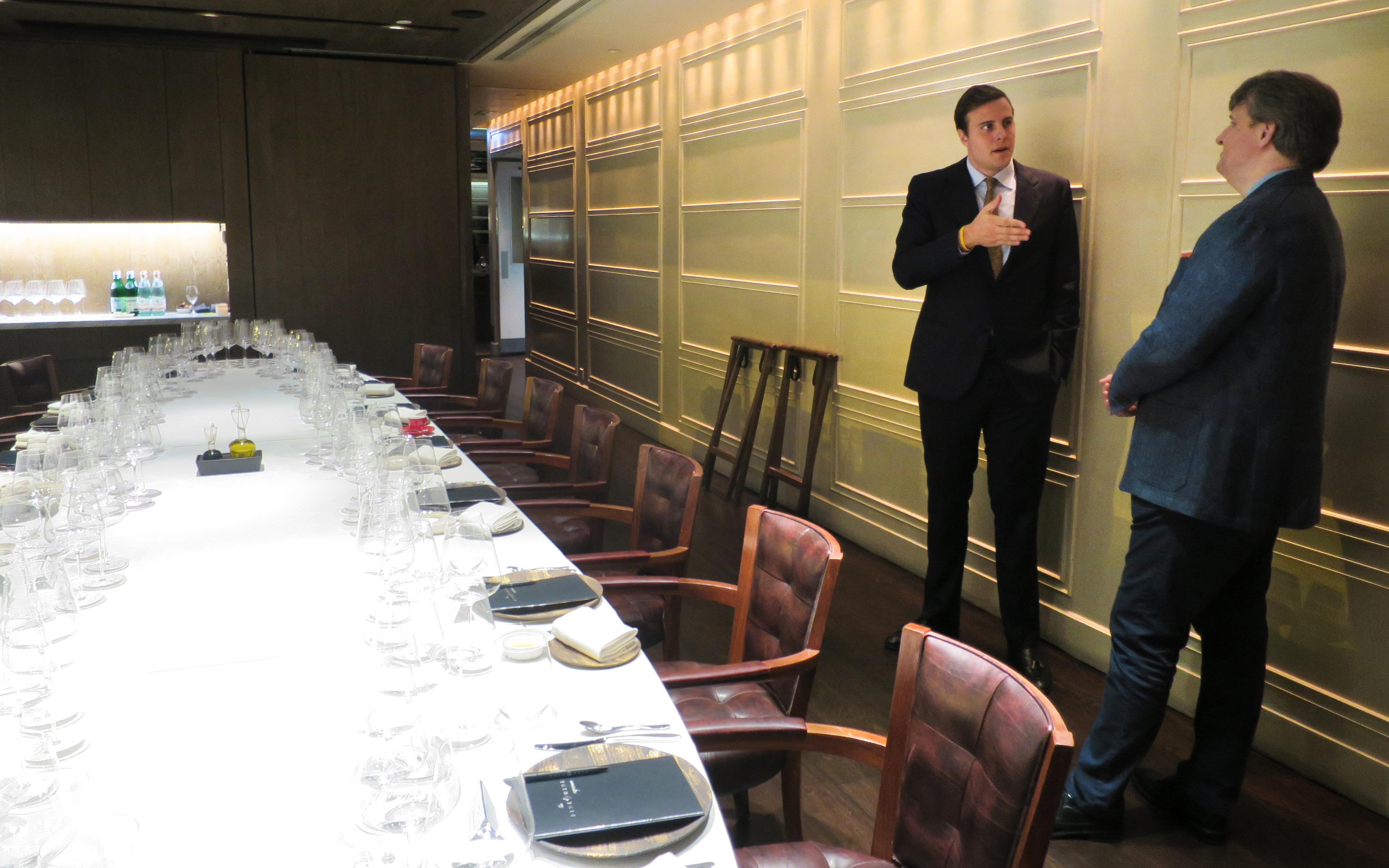
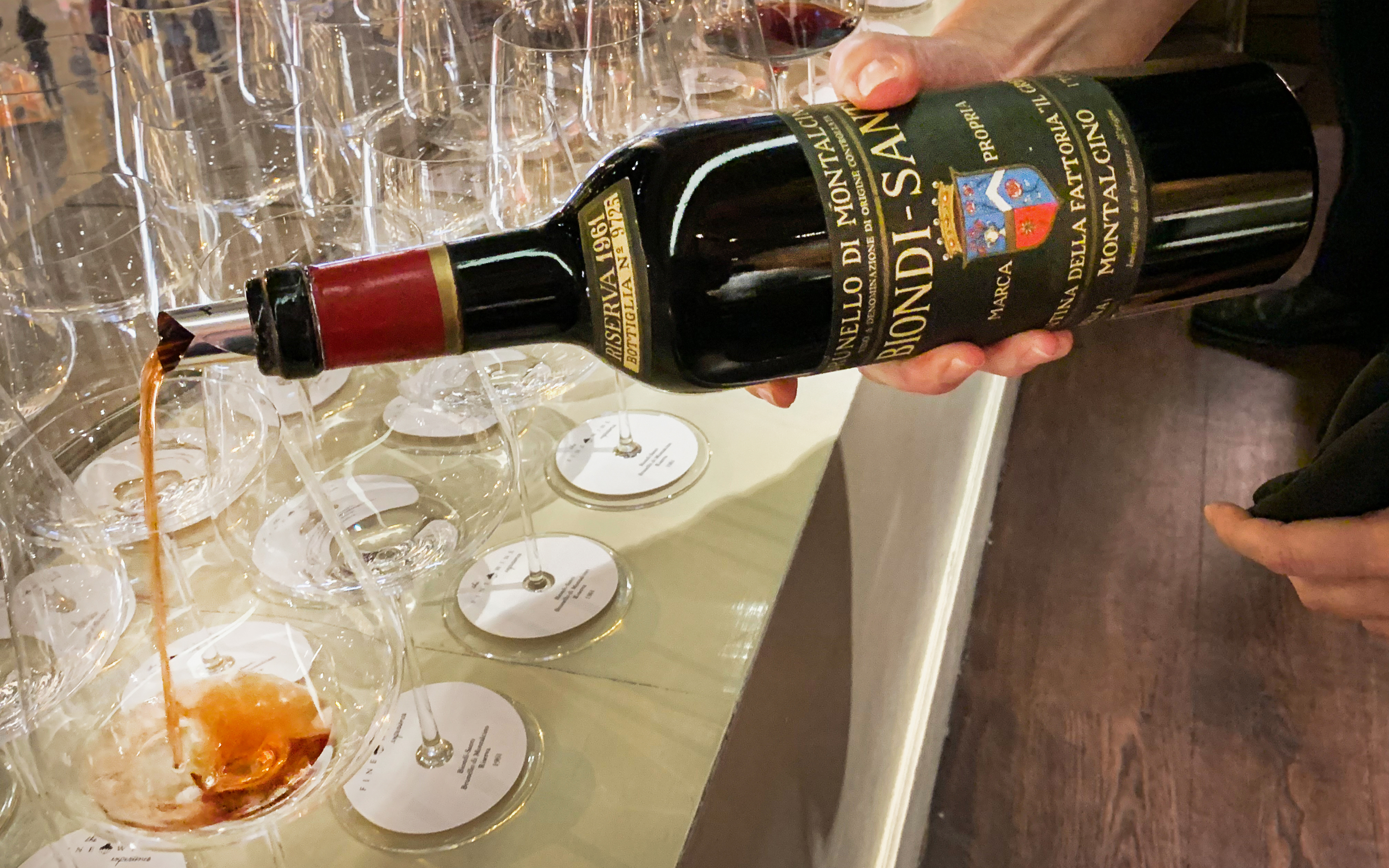
8½ Otto e Mezzo Bombana , Hong Kong, 28th October 2018
Grissini, Hong Kong, 29th October 2018
The Tasting Room, Macau, 30th November 2018
© Linden Wilkie
On December 31st 2016, my wife and I stood in the centre of the little town of Montalcino in Tuscany’s Val d’Orcia, an impossibly beautiful Renaissance painting ideal of the Italian landscape. We weren’t feeling the beauty; we were feeling the cold. The mercury registered something like 7°C, but the wind cut through our warm winter coats. Pretty soon the warmth of the car won over any notion of exploration. Montalcino, the district, sits at the 650m peak of Montalcino, the hill of vineyards.
I was recalling this scene as Tancredi Biondi-Santi presented his estate and his wines to a group of attentive sommeliers in Macau last week, ahead of the third consecutive Biondi-Santi dinner we helped arrange and host as the estate’s HK and Macau importers. “I am Tancredi Biondi-Santi, the 7th generation in this wine family. The 1st, Clemente Santi (1795-1885), invented Brunello di Montalcino, and the style has never changed.” A glass of the 2012 in my hand as he spoke, I thought of what it must take to hold your core idea and to stand against the winds of fashion for generations. If we turn that telescope of time around and look back from the present, today there are some 254 producers of “Brunello di Montalcino”. In 1988, there were 85, in the mid-60s when the DOC was created just 12, and originally just one, Biondi-Santi. “At the time of Clemente”, Tancredi went on, “you have to imagine that this was a radical vision. The village was already famous for wine, but it was Moscadello, a sweet wine. You might as well live in Champagne and say that your vision is to make a great pear liqueur!” In 1869, Clemente’s idea for a red wine from the local clone of Sangiovese Grosso, but aged won him a prize. The wine style gained its own new description – “brunello”, or browning one.
Clemente’s son, Ferruccio Biondi-Santi (1849-1917) formalised the style, and left behind the proof of the family’s vision of a fine red wine with longevity, a Brunello di Montalcino Riserva from 1888 and then 1891. Two bottles of the former and three of the latter remain in the cellar. Nick Belfrage MW gave the 1888 a perfect score at a tasting in 1995, and Tancredi told us of his experience of the 1891 – “my grandfather opened a bottle for the family for his 60th wedding anniversary in 2009. The wine is old but still beautiful, and it is exactly 100 years older than me. It was incredible.”
It was Ferruccio’s son Tancredi Biondi-Santi (1893-1970) who brought the now family style to the Italian and then international stage. The period between the wars were difficult times. A Riserva was made in 1925, but that’s it for the first half of the century – the family putting efforts into broadening the farming and production of Brunello wine through the Cantina Sociale di Montalcino. But at the end of Prohibition, they did manage to achieve their first exports to the United States. It was the post-World War II period that really saw things flourish. Riservas were made in ’45, ’46, ’51, ’55, ’57, ’58, ’61, ’64, ’67, ’68, and ’69 and fame grew. Frank Sinatra was a fan, and the ’55 was served at an official dinner for Queen Elizabeth II in 1969. Indeed, in 1999, James Suckling ranked the ’55 Biondi Santi Brunello di Montalcino Riserva one of the 12 greatest wines of the 20th Century, alongside such collector unicorns as 1900 Margaux, ’61 Pétrus, ’37 Romanée-Conti, ’45 Mouton and so on.
So what was the secret to this success? There seem to be four main factors. First, the land itself. As Tancredi (Jr.) is keen to point out, while there is (like in Corton) a wide range of orientations to consider (vineyards in different plots at the estate divide up the points of the compass quite neatly) the zone really has two key layers – the lower part on clay, and the upper part on ‘galestro’ soil – a mix of schist and clay. “The galestro is a poor soil that makes the vine’s roots go deep, and it gives a minerality to the wine that is essential for quality.” Second, is the clonal material, and Biondi-Santi’s is unique and proprietary. During the phylloxera crisis plants already existing at the property were tested for grafting on Amercian rootstock. From these a study was made of 40 plants, and the best of these – the 11th – was selected and propagated and is today what comprises the estate’s vineyards. It is “BBS11” – Brunello di Biondi-Santi 11. Tancredi feels its characteristics are quite distinct. The third is a combination of vine age and the timing of the picking. Young vines (5~10 years) may only go into the basic designation – Rosso di Montalcino. Adolescent vines (10~25 years) may only go into the estate’s main wine – Brunello di Montalcino ‘Annata’, while ‘Riserva’ may only come from vines 25 years and older. Interestingly, the picking follows almost a reverse approach. The grapes for a potential Riserva are brought in first to pinpoint an optimal balance between phenolic maturity and acidity – acidity is seen as a critical component for the aim for Riserva – a wine capable of a century of bottle age. Annata is picked next and Rosso last. The fourth component is a traditional approach to winemaking and a very conservative approach to labelling. Rosso is straightforward stainless steel tank fermented, and is intended for young enjoyment. Annata and Riserva are closer – Annata fermented in tank (and in the past in vitreous lined concrete), while Riserva is fermented in large old, neutral wood of Slavonian oak. Criticially, though, both Annata and Riserva are matured exclusively in large old, neutral Slavonian oak vats for 36 months. During this process the family and their team make critical tastings and trial blends before deciding which – if any – vats are deserving of Riserva bottling. Since the 1888 vintage, only 38 vintages have made the cut.
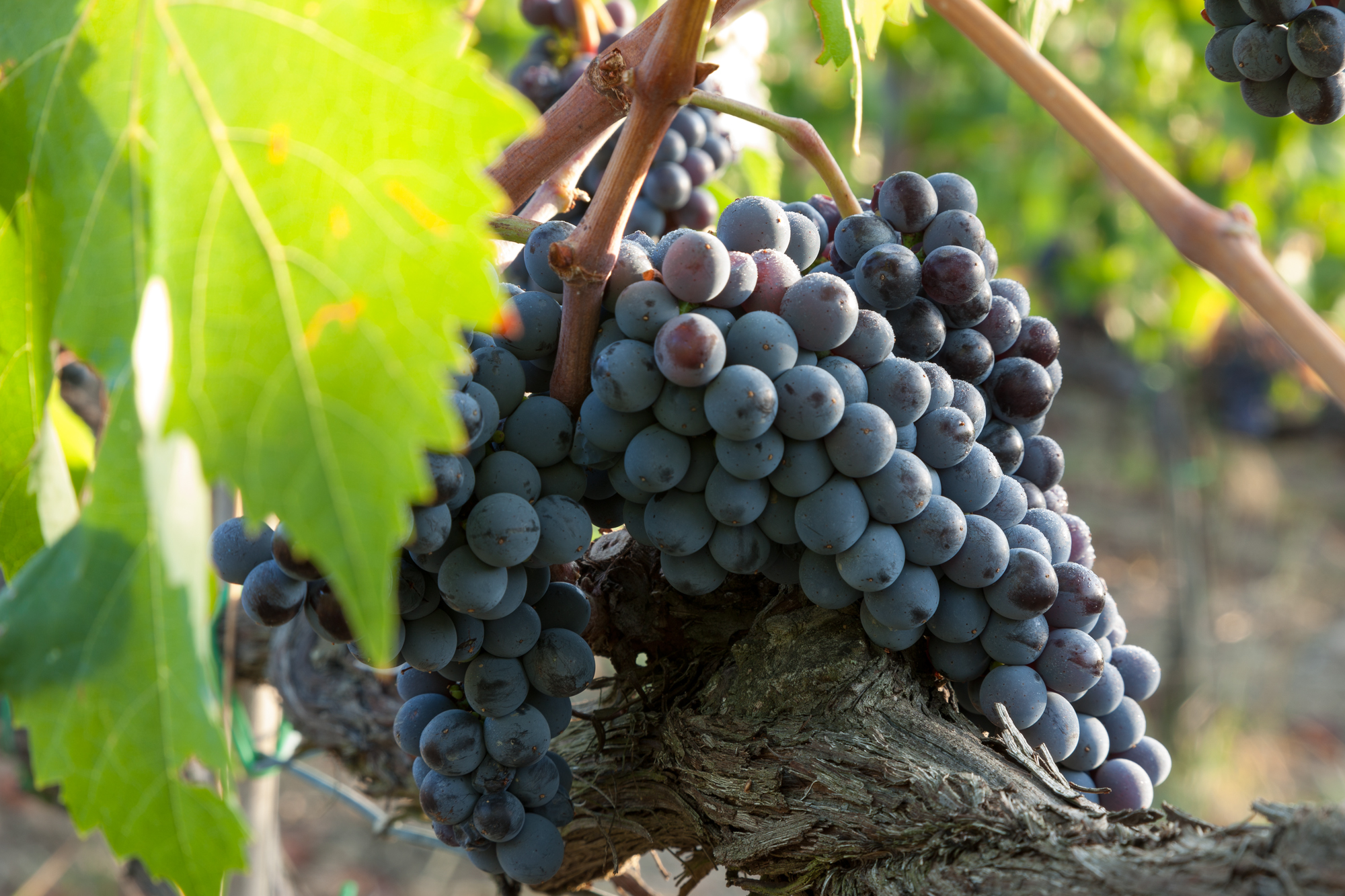
BBS11 – Brunello di Biondi-Santi 11 © Biondi-Santi
The result is a wine of great quality, though frankly, we must acknowledge that thanks to scientific advances in viticulture and oenology, great quality is more common to find today than in Clemente and Ferruccio’s day. More critically I think today, the result at Biondi-Santi is wines of personality, a sort of authenticity – each generation having brought its own nuance but the overarching result has been one of continuity and faithfulness to the original style. To listen to the 27-year-old Tancredi speak today is to hear a heartfelt commitment to this ideal.
My curiosity to this style led me in 2005 to organise a vertical tasting for The Fine Wine Experience in London. The star wine that night was the 1945 Riserva, a bottle gifted to us for the night by Franco Biondi-Santi (1922-2013). The case for ageworthiness – at least for me – was then settled. Perhaps the more interesting experience, however, was tasting the 1990 Riserva amongst 23 Brunellos from that vintage that I served blind at a dinner. For quality I ranked the wine high, but for style there was no question which wine was the Biondi Santi Riserva – it was both elegant (A Biondi-Santi is always a transparent, never opaque wine, even young), and still very youthful and uncommonly bright with zingy penetrating acidity.
At 8½ Otto e Mezzo, Hong Kong
The first of our events last week with the young Tancredi was an exploration of the Riservas (’11, ’97, ’93, ’90, ’88, ’85, ’83, ’82, ’81, ’75, ’71, ’70, ’69, ’68, ’61, ’55) at Hong Kong’s altar of Italian gastronomy, Otto e Mezzo. There was a remarkable consistency of style to the wines, and what a particular style it is. The first thing to speak about is the acidity, which is ripe, but elevated. More than once, in trying to describe it, my thoughts turned to great whites rather than great reds to make clear to myself with my pen what I was experiencing. I had just come back from two weeks in Burgundy, and I found myself more than once writing “white Burgundy acidity”. Yes, white. If you think about the structure – the real architecture – of a great white Burgundy, in combination with depth of extract and fruit is the acidity, and this is logical because there is very little tannin. Second, there is a complete absence of the vanilla fragrance and coarse, furry-textured tannins of new and young French oak barriques for the obvious reason that none are employed. Finally, the tannins coming from the fruit offer some grip (varying from a touch dry to taffeta-silky, depending on the vintage and era) but never to a point where inner-mouth fragrance fails to be prominent and complex. Just as often in texture I found the fine transparent creaminess of extra virgin olive oil (perhaps a suggestible cultural association). The overall sense with the Riservas is of naturally-expressive refinement and nuance, subtle complexity, right in the mould of what the Italians apparently refer to as vini da meditazione – meditation wines – i.e. wines for conversation and contemplation rather than food. Tancredi confirmed that when the family drink the Riservas they are usually unaccompanied by food. Pressed a little bit more on what he thought might be a good food match, he said that recently they have been experimenting with fish dishes (!). Well, as if ready to underline Tancredi’s point, the second dish at the Otto e Mezzo dinner was warm blue Brittany lobster tail with a delicate jus that included a touch of Brunello wine. The meat was succulent, and the delicate sauce autumnal in tone – it proved a very successful partner to the brightest of the three in the flight – the 1969 Riserva. Beyond this however, Tancredi’s advice seems more conventional – particularly with the Annatas he likes game – fallow deer, wild boar, various birds, roasted on the fire. (Tasting Room’s Alsace venison with Sauce Sangria was perfect with the ’07 Annata).
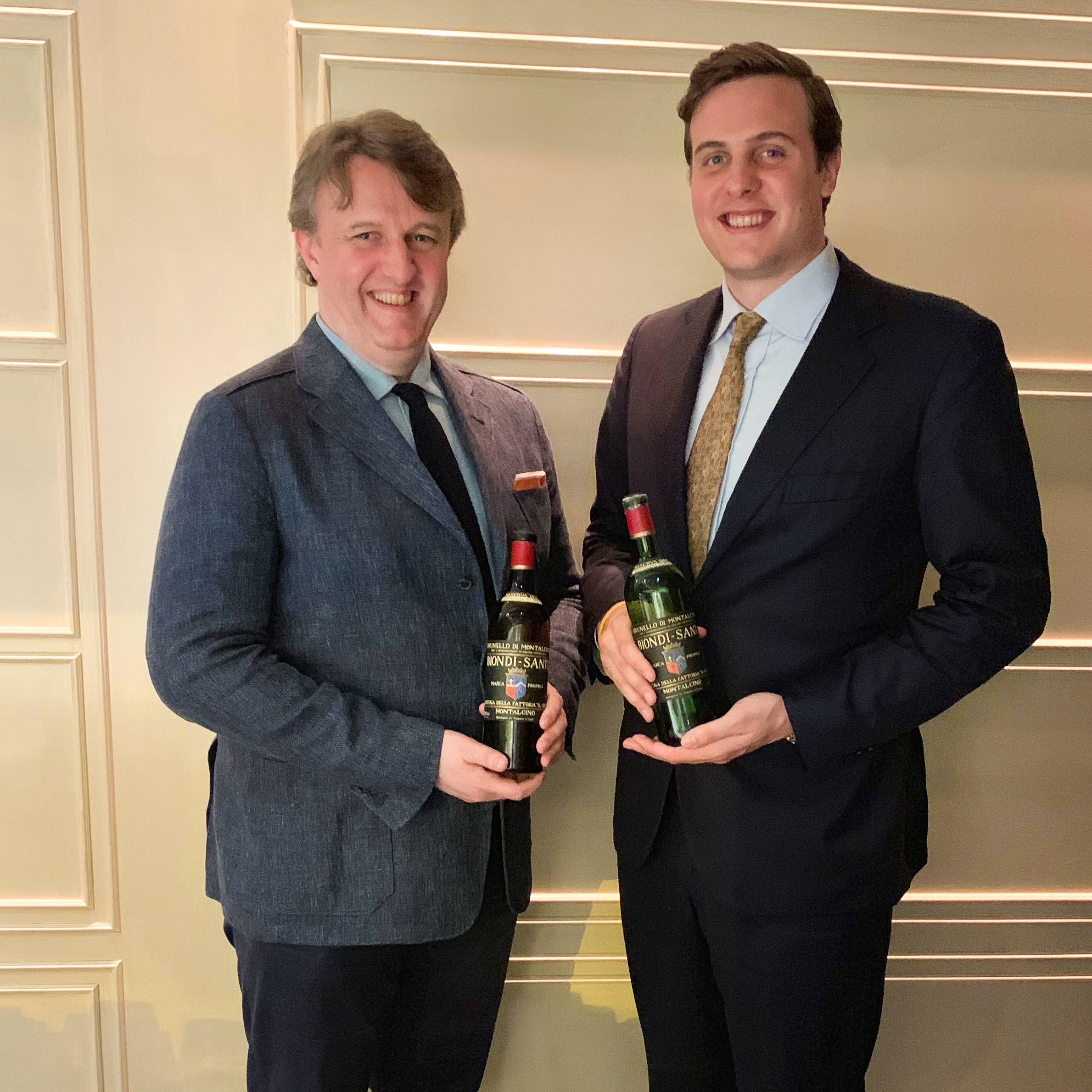
While any one of the sixteen Riservas we served at Otto e Mezzo would stand out for its distinct personality in a line up of other wines, within this vertical it was possible to discern subtle style shifts – nuances – and Tancredi kindly shared some background on this. Franco’s approach in the ’70, ‘80s and ‘90s put a little more emphasis on the acidity than his father Tancredi or his son Jacopo would go on to do. The ’81, ’82, ’83 flight was also revealing for what the wooden fermentation vessels brought. The ’81 and ’82 were in cement, while the ’83 saw a return to wood. While ’83 is the big classic vintage in any case, the tannins and acidity felt more pinched in combination in the ’81 and ’82, as if the wine needed more opportunity to ‘breathe’, and in ’83 it got it.
If there is a weakness in any of the wines it is an element of brettanomyces (“brett”) - a kind of yeast – which can be detected in some of the wines. I use the term ‘weakness’ cautiously here, because a small amount of brett’s savouriness can be a positive attribute in wines for many people (me included). Its savoury tone offering a morish sort of counterbalance to the fruit’s sweetness. But if it is present in the wine, the wine can vary bottle to bottle in how much brett character is displayed, and storage conditions will play an amplified role in this regard. This evening brett really only spoiled it for me with one wine – the 1971 – which was otherwise great, but the brett had taken on an almost feral, mousy sort of dimension. Our bottle of 1961 – good as it was – was paler than expected, and I think may well have been below par for this wine.
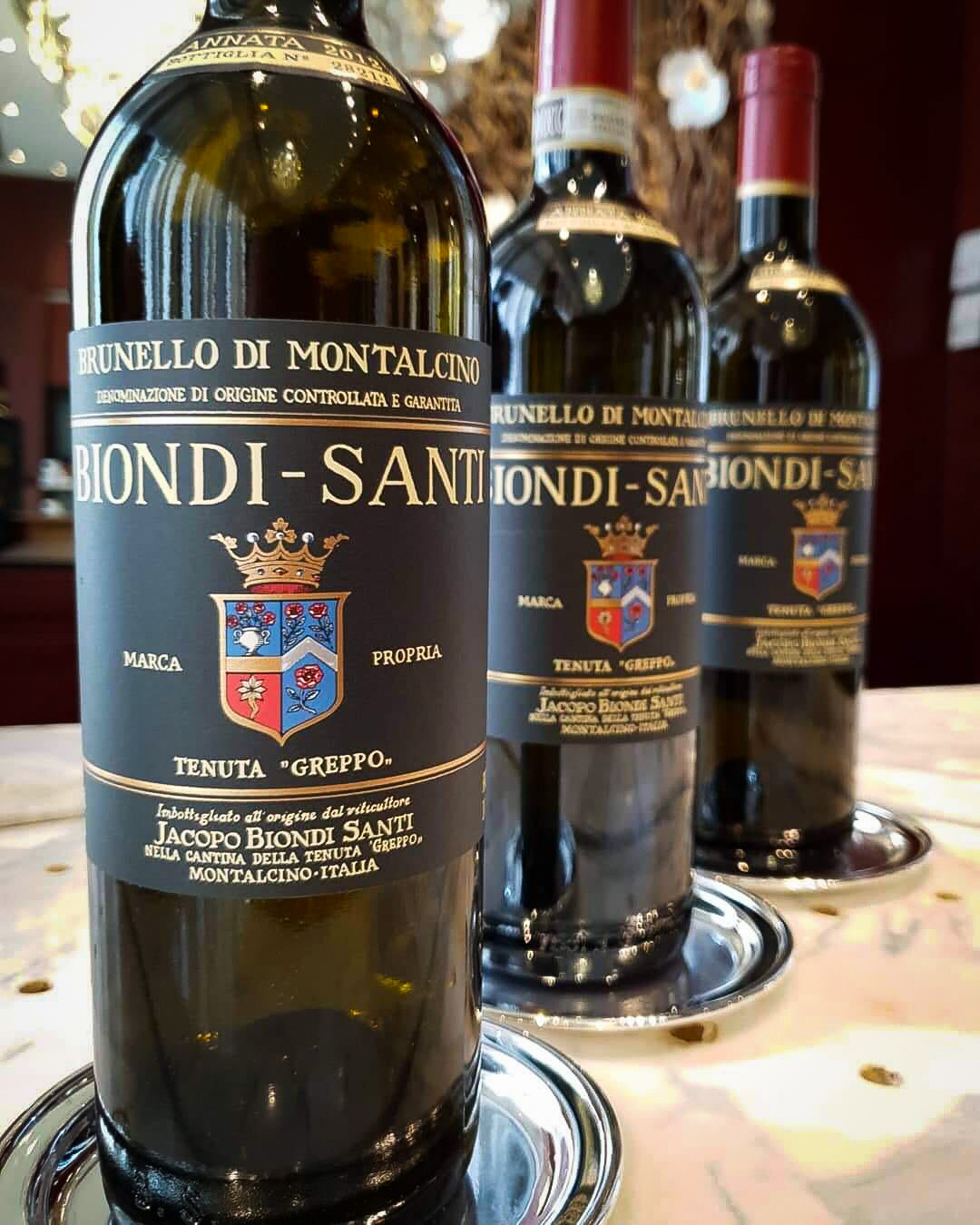
At The Tasting Room, Macau
Overall, though, I think we had a good run, and a number of the wines were truly magnificent. Two other peculiarities came through in the flight. First, reconnecting me with the experience of my 2006 horizontal of 1990 Brunelllos, was just how slow to evolve the Riservas are. The 1997 Riserva is still fresh, vibrant, youthful even. There is a little variation bottle to bottle (tighter, slightly leaner at Otto e Mezzo, a little more expressive and full the next night at Grissini, and open and ready the next night at Tasting Room in Macau), but compared to 1997 top-tier Tuscans in general, on all three nights the 1997 Riserva seemed amazingly youthful. This was a great vintage in Tuscany – subject to something of a wine critic frenzy at the time (boosting interest in the wines globally), but the style was rich, fat, and relatively low in acid. The Biondi-Santi must have seemed such an odd man out back at that time (indeed, it was released long after the hype had subsided anyway). Today, it is vibrant and complete, still very fresh, very true to the Biondi-Santi style, and still on the ascendency. It will have the last laugh as many of its high-scoring contemporaries are in rapid descent to oblivion. No harm – the wines were enjoyed, weren’t necessarily sold as ‘keepers’, and that fat smooth style appeals to a wide audience. But for Biondi-Santi, their 1997 Riserva in 2018 must taste like a vindication of the approach laid down for generations.
Roasted Scallop, Guanciale, Celeriac Foam with White Truffle,
created by Chef Alessandro Cozzolino at Grissini Hong Kong
The Annata wines offer a very similar style and expression (like the Riserva, it is aged 36 months in large, old Slavonian oak), for about a third of the price. Ageworthy in its own right, it is approachable sooner and has a very similar aromatic and acid-structure driven style. Following the Riserva-focused dinner on Wednesday, on Thursday and Friday’s dinners we split our attention between Annata and Riserva. In much the same way as a glass of La Romanée will spoil the perfectly lovely experience of a glass of Vosne-Romanée 1er Cru ‘Aux Reignots’, there is a clear step from Annata to Riserva, particularly in the sense of grace and in palate length. But I’m a real fan of the Annata. The 2012 Annata – the current release – offers a particularly clear window into the style, still young, but fully transparent garnet in the glass; it is bright, a little tight in palate-feel but wonderfully nuanced and complex. The 2010 is just a little less broad aromatically but has a fuller, more melting texture, and baby-Riserva-like length. It’s a sleeper, and clearly the sort of once-in-a-long-time vintage that allows everything to step up. The 2007 shows where Annata can go in terms of bottle age. For me it is a bit less refined than the ’12 or ’10, is more savoury in tone but is also just a bit richer and more forward. It was the favourite of the three Annata’s at our Grissini dinner by popular vote.
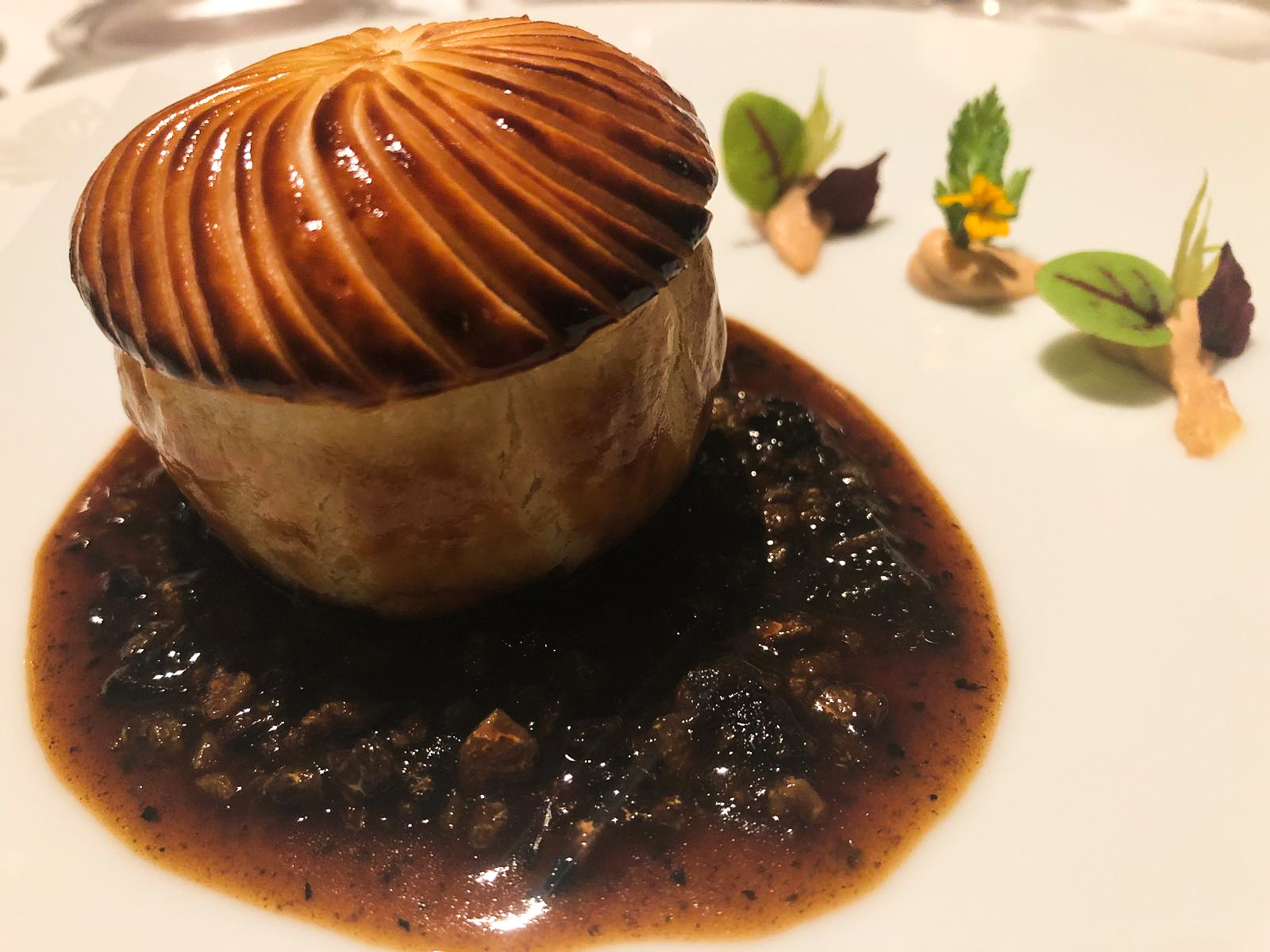
Porcini Mushroom And Foie Gras Wrapped In Feuilletage, created by Chef Fabrice Vulin at The Tasting Room Macau
Whatever it is you are opening, my experience is that the estate’s advice on preparing the wine is worth following. The Riservas, it is recommended, should have their corks removed about 3-4 hours before service – yes, even (perhaps especially) the really old ones. This introduces a small amount of oxygen which in a very gentle way begins to open to the wine. Then pour the wine and let it do the rest in the wine glass – no decanting. (Though, if you prefer no sediment in your wine, you might transfer to decanter first after the four hours in open bottle to take the wine off its sediment, but this is not part of the estate’s advice, so we didn’t do it). In all cases the wines continued to open considerably in the wine glass, and almost without exception for the better. The 1985 reached lift off just as we were leaving the restaurant, and the 1955 – a little unpromising to smell in bottle when opened, was good when served, and then brilliant after another 30 minutes in the glass. If you want to really enjoy these Biondi-Santi wines give them time to breathe.
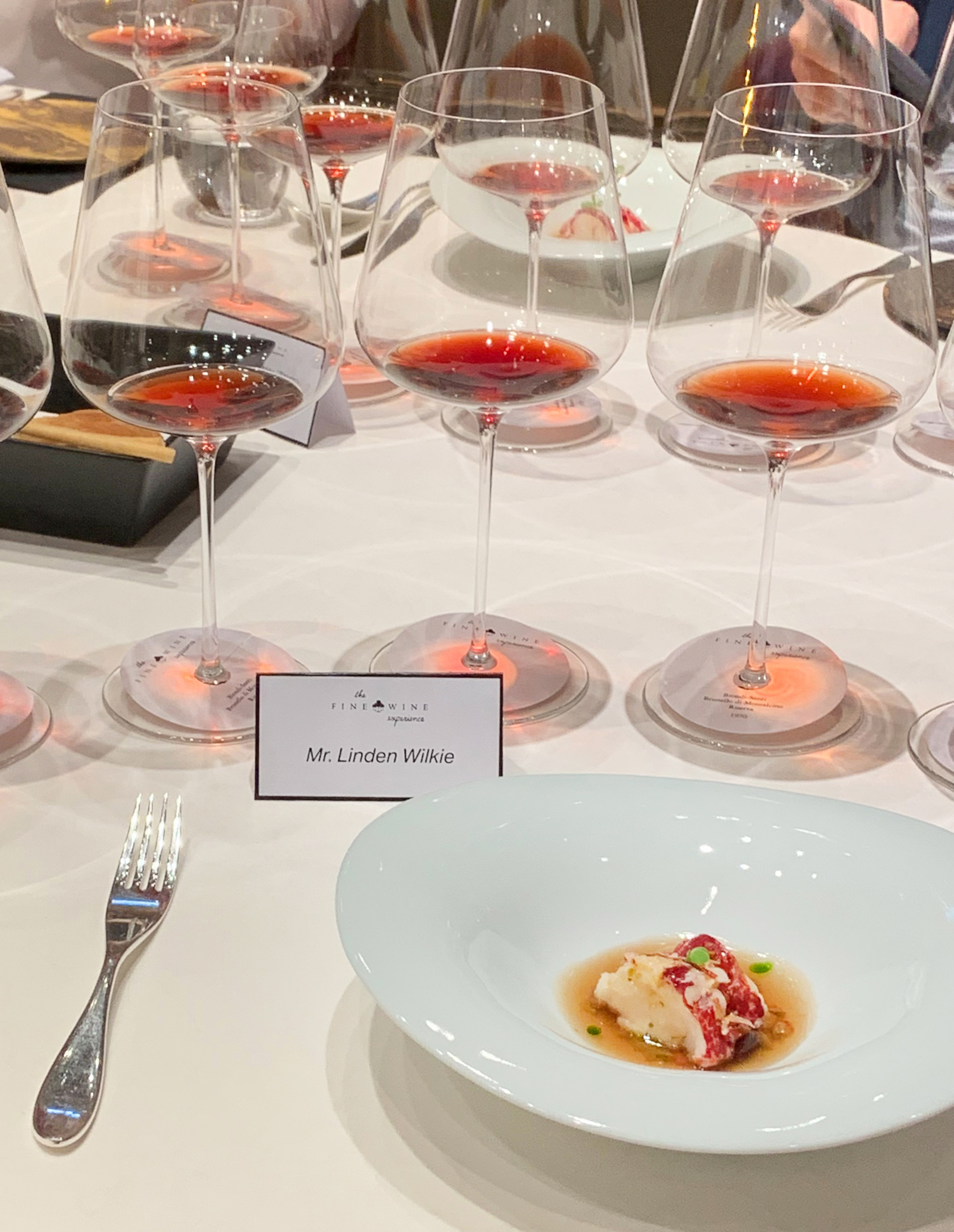
Warm Blue Lobster with Brunello jus, paired with
Biondi-Santi Brunello di Montalcino Riserva ‘70, ‘69 & ‘68 at 8½ Otto e Mezzo, Hong Kong
There’s one final point I’d like to touch on before moving on to the individual tasting notes – and that’s Biondi-Santi’s re-corking programme – ‘ricolmatura’. From time to time the estate chooses vintages for recorking, including their own cellar reserves. Clients are invited to bring (or send) their bottles of the same wine back to the estate. The corks are removed one by one and each bottle tasted by Tancredi’s father, Jacopo Biondi-Santi (1950-), approved as sound, topped up with the same wine of the same vintage, recorked and capsuled. A certificate notes the process and date, signed by Jacopo and a notary. Recorking for customers is a dwindling tradition amongst the world’s top estates – Lafite used to travel to great cellars to do it, and Penfold’s is well known for their recorking ‘clinics’. But few offer the service of topping up with the same vintage from their own cellar, a factor that keeps the expression of the wine entirely original, rather than ‘refreshed’. It’s a programme consistent with both their pride in the longevity of their Riservas, and the practical acknowledgement that wines that can outlive their corks need recorking (or, of course, drinking!).
A big thanks to Kenji Torres and Umberto Bombana at 8½ Otto e Mezzo, Julien Peros and Alessandro Cozzolino at Grissini, and João de Melo Pires MS and Fabrice Vulin at The Tasting Room and all the professionals at these venues who helped make this a wonderful three day Biondi-Santi-fest.
Three days with Tancredi Biondi-Santi were a real pleasure too and quite an education. They left me yearning for the chance to revisit Tuscany, and make a second attempt to explore the village of Montalcino - though perhaps this time it should be in summer!

2012 Biondi-Santi Brunello di Montalcino Annata
Grand Hyatt Hong Kong Biondi-Santi dinner, Grissini, 29th November 2018 92
Fresh, mid-ruby, clear appearance; fresh and taut on the palate, a touch of currants in the fruit profile, still youhtful, though complex notes come through – herbs, brush, and just a touch of wood; spicy, crunchy-textured fruit on the palate, lightly creamy, it stays very transparent and driven by its juiciness. This has the fragrant charm of Sangiovese at its most expressive and at ease with itself – no makeup here. Red fruit, fine grip. The 2012 has the range, the complexity and the length. It is not as deep as the 2010 but conveys the breadth of the personality more readily.
No votes for favourite of the three Annata wines of the night.
Tasted now several times, this wine is highly consistent.
2011 Biondi-Santi Brunello di Montalcino Riserva
Riserva vertical, Otto e Mezzo, Hong Kong, 28th November 2018 94
Light, bright ruby, just slightly faded in colour; a sweet nose, red cherry, cherry pit, a touch floral, some green almond and also a little panforte cake ‘singed’ sweetness, the aromas are open and expressive, already very enticing; the palate is sweet, round and pure, melting in texture, very fragrant, with the texture of fine extra virgin olive oil and satin, the acidity is noticeably lower than the typical Riservas of old, but the style is still true to them. The very fine grip is noticeable when you look for it, and I am confident this will age and evolve well, but – atypically – there is no need to wait.
No votes for wine of the night.
Grand Hyatt Hong Kong Biondi-Santi dinner, Grissini, 29th November 2018 95
Fine ruby garnet with just a touch of evolution detectable at the rim of the glass; a very complex nose, aromatic, open and expressive, wild raspberry, red cherry, brush, Cuban cigar tobacco, a touch floral; very fine texture, round and palate-coating with fine acidity, a touch of tobacco again, spices and even hint of white chocolate. This is precoecious for a Biondi-Santi Riserva; it shows superb complexity and is already enjoyable to drink. It was absolutely spectacular with the roasted pigeon with lentils, peppered beetroot cream, and raspberry with pigeon jus.
4 votes for favourite of the three Riserva wines of the night.
2010 Biondi-Santi Brunello di Montalcino Annata
Grand Hyatt Hong Kong Biondi-Santi dinner, Grissini, 29th November 2018 93
A touch deeper in colour than the 2012 Annata; a sweet, candied violet led nose with notes of spices and fine perfume; really lush but also fine-boned and tender, minerality here, great length, more concentration. It is also more compact than the ’12, showing youthful reserve. Fruity and more in the Annata than Riserva style, but this has quality touching the Riservas and as such offers a relative bargain buy.
6 votes for favourite of the three Annata wines of the night (2nd place).
Tasted now several times, this wine is highly consistent.
2007 Biondi-Santi Brunello di Montalcino Annata
Grand Hyatt Hong Kong Biondi-Santi dinner, Grissini, 29th November 2018 89
Fine ruby-garnet; a more evolved open ripe nose, with a touch of brett, sweet berry confit fruit –a sunny vintage smell; lush but bright on the palate, sweet confit berry and a touch of cherry but also cranberry, brush and a touch of smoke – there is a distinctly savoury undertone to the sweet richness of this wine. Moderate length (not as long as the ’10 or ’12). Overall, this is a richer, more open style than typical for Biondi-Santi but also less elegant and refined – there is a coarseness to the tannins and a bit of burliness to the tone, and for me that makes the 2007 a relative disappointment.
7 votes for favourite of the three Annata wines of the night (1st place).
The difference between my note/score and the dinner group’s top place ranking can partly be explained by differences in preference but also perhaps bottle variation (two bottles were served). Over three days I tasted this wine four times and noted differences, this wine at best showing a little more coherence and brightness of tone and fruit. That said, some of the votes came from people who drank from the same bottles as me at Grissini, so personal taste is obviously a factor.
1997 Biondi-Santi Brunello di Montalcino Riserva
Riserva vertical, Otto e Mezzo, Hong Kong, 28th November 2018 94+
Fine mature garnet, limpid; ripe nose with notes of brush and spice and a touch of smoke, freshness still in the expression of red fruits and cherry; good intensity in the attack, full and spicy, full fragrant fruit, spices, a touch of panforte, and very fine tannin. Retasted after another 45 minutes in the glass, and right after the ’11, the more classic, grander structure is evident here. There is just a slight pinch at the end. There’s real tension, and that is a very interesting thing considering the natural (over?-) generosity of the ’97 season. Many ‘97s are now in decline, however great they were. Yet, this one seem so fresh, so vital. It is just beginning to stretch its legs.
2 votes for wine of the night.
Grand Hyatt Hong Kong Biondi-Santi dinner, Grissini, 29th November 2018 95
A deeper ruby-garnet than the 2011 Riserva; sweet, ripe fruit with scent of fine Cuban cigar, sweet, bright fruit and just a touch of volatile acidity lifting the whole package; fine, round, lush on the palate but with bright zingy acidity giving this a kind of sapid juiciness and sucrosity with fine svelte mineral-laden tannins in support. Then a very long finish that lingers with a note of olives. This wine seems to find the perfect balance between 1997’s exuberant fruitiness and the house approach for a little more strictness and freshness. A great wine, still so fresh and vital – tonight’s bottle just a little fuller than last night’s.
7 votes for favourite of the three Riserva wines of the night (1st place).
I tasted this a third time the following night at Tasting Room in Macau – it was similarly brilliant, but even more open and exuberant. My favourite bottle of the three was at Grissini.
1993 Biondi-Santi Brunello di Montalcino Riserva
Riserva vertical, Otto e Mezzo, Hong Kong, 28th November 2018 91
Bricked appearance; fine, mature nose, complex, some fine fruit still, a subtle campfire note; fine, well-balanced, sweet, supple, bright and complex; overall, this shows a cooler, more introspective sort of expression. The complexity gives it interest, but it does not have the same length on the palate as the best examples.
No votes for wine of the night.
1990 Biondi-Santi Brunello di Montalcino Riserva
Riserva vertical, Otto e Mezzo, Hong Kong, 28th November 2018 91+
Fully bricked with plenty of garnet remaining; sweet and initially showing a little VA-lift (this blew off), this initially showed a smoky spicy personality, with a scent that included Cuban cigars; taut and sweet on entry to the palate, the bright acidity pulls it taut from the mid-palate where the tannins feel taffeta-like; there’s a touch more tension still in the long finish where everything is pulled tight like a corset. This is not a typically voluptuously-styled 1990; it is indeed a touch lighter and leaner in intensity than expected, and additional time in glass did not reveal more this evening. Tancredi, much more experienced with this wine than me, feels it is currently in a closed period. I can believe this based also on my own experience, having found it more open when I tasted it in 2006.
1 vote for wine of the night.
1988 Biondi-Santi Brunello di Montalcino Riserva
Riserva vertical, Otto e Mezzo, Hong Kong, 28th November 2018 94
Garnet with a broad tawny rim; smoky, biscuity, sesame notes, a little decay at first, I wasn’t fully convinced by it initially; the palate quite rich, this has real extract and dimension on the palate, mature, complex, mouth-fillingly satisfying, and there is potency too. There is a slight scratchiness to the acidity but with enough depth and complexity to forgive this slight coarseness. At least this is what I felt in the first hour it was in the glass. When I returned to it, I found it fuller, more harmonious, more at ease with itself. Ultimately, I found it great and wondered if it was not in fact the perfect combination of vintage type (classic without being excessive) and estate approach (working more for expression and longevity than plumpness and power). It all seems to come together in the ’88.
2 votes for wine of the night including one of mine.

1985 Biondi-Santi Brunello di Montalcino Riserva
Riserva vertical, Otto e Mezzo, Hong Kong, 28th November 2018 95
Lovely, bright fresh colour, a bricked garnet with fire rim; the nose was initially not fully expressive, like wet earth, though also with fresh sweetness and spice; full, and very round on the palate relative to the Riserva style in general, this has great texture, powdery fine tannin, olive oil and white Burgundy-like acidity, this has a very gentle, caressing and mouth-coating palate-feel, the fine acidity pushing and extending the long finish. It was only after another two hours – indeed just as we are leaving the dinner when I gave it one last look, that the nose really unfurled with a very beautiful, floral-laced fruitiness – a little sense of the fireworks that were awaiting on the palate. This 1985 is bursting with energy, those two extra hours seemingly transforming the wine into something younger than first poured. Clearly, one of the greater Riservas, but give it all it needs to breathe.
1 vote for wine of the night.
1983 Biondi-Santi Brunello di Montalcino Riserva
Riserva vertical, Otto e Mezzo, Hong Kong, 28th November 2018 93
Garnet with a bricked rim; a sweet, biscuity complex nose with dried herbs, ripe and full; full on the palate, obviously more generous than the 1982 and 1981 served alongside it, lovely fine spine of acidity gives the fullness of the extract a very juicy feel, fine tannins. This is a harmonious and elegant wine, and I felt that tonight it seemed this bottle seemed at its absolute zenith – neither unready in any way, nor in any sort of decline. Very expressive and complex with beguiling fruit, a joyful sort of wine.
1 vote for wine of the night.
1982 Biondi-Santi Brunello di Montalcino Riserva
Riserva vertical, Otto e Mezzo, Hong Kong, 28th November 2018 88
A touch lighter in colour than the ’83, fully bricked; an earthy sweet, spicy leathery nose; fine, more a sense of power than the 83 but that is delivered with more grip and a slightly bitter twist in the tannins at the end. Overall complex and interesting but lacks the balance and sheer pleasure of the ’83.
No votes for wine of the night.
1981 Biondi-Santi Brunello di Montalcino Riserva
Riserva vertical, Otto e Mezzo, Hong Kong, 28th November 2018 91
Fine bricked appearance with a fully tawny rim; leather, spice and intriguing complexity of spices and subtle scents; the palate is sweet, evolved, it share’s with the ’82 a very slightly pinched feel with a slight bitter astringency, but less so – there is more harmony here even if there is also a little less power. Indeed there is almost the harmony of the ’83, but less richness, this is more slender in feel. I might well have passed over it ultimately, but it grew impressively in the glass – one of the most impressive transformations of the 16 Riservas tonight, it became more complex, more ‘meditational’, with great clarity of exression, but it remained a lighter, very elegant wine, for the lightest of dishes or to enjoy on its own.
No votes for wine of the night.
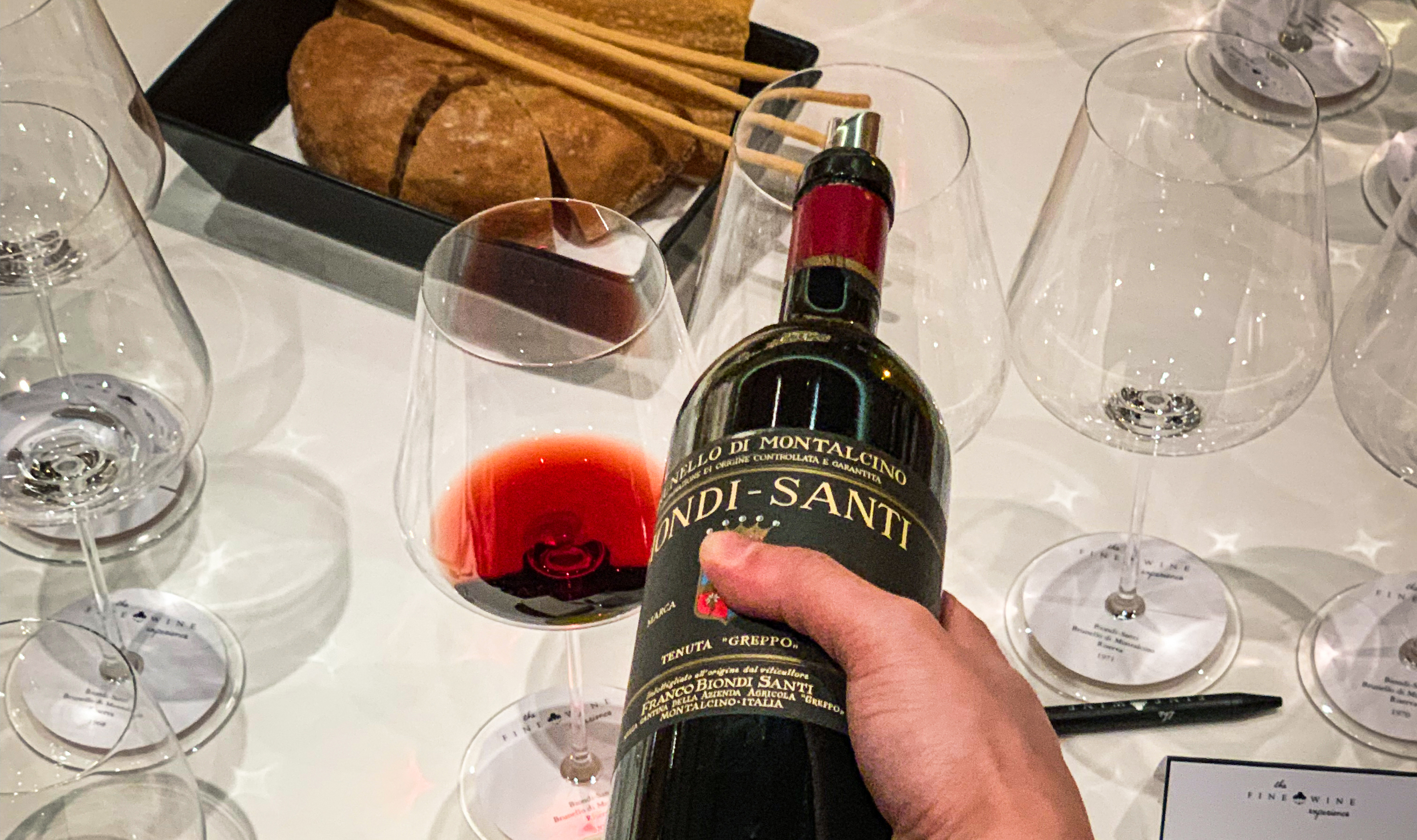
1975 Biondi-Santi Brunello di Montalcino Riserva
Riserva vertical, Otto e Mezzo, Hong Kong, 28th November 2018 94
Fine bricked colour – not too different to the ’97 or ’85 – pointing to the relative depth of this wine; ripe and spicy on the nose, some leatheriness too, also pointing to tannin and richness, but the nose is not blunt, there is real nuance and complexity to it; perfect harmony and balance awaits on the palate, juiciness and extract to match with authoritive richness. It’s fully mature, sweet and bright, with a touch of licorice and brush scent in the finish. I really like this, and it is drinking perfectly right now.
3 votes for wine of the night – 3rd overall.
1971 Biondi-Santi Brunello di Montalcino Riserva
Riserva vertical, Otto e Mezzo, Hong Kong, 28th November 2018 89
Bricked with an orange rim; a sweet nose, fragrant, though a little moussy at first with a little touch of porcini but sweet, full and fragrant, fully open; taut on entry on the palate, but there is evident concentration – seemingly more than the ’90 for example, a sweeter profile of fruit, and this is the wine’s real charm tonight – complexity and roundess and more cherry in the fruit. That said, the level of brettanomyces is noticeable and intrusive.
1 vote for wine of the night.
1970 Biondi-Santi Brunello di Montalcino Riserva
Riserva vertical, Otto e Mezzo, Hong Kong, 28th November 2018 84
Fairly limpid tawny; sweet, in that decay and chestnut sort of way on first serving, sweet panforte cake; a bright sweet attack with bright acidity and fine balance, but there is too much toffee here, real oxidation and perhaps a little poor storage damage has affected this bottle. As it opened further it declined – rich, raisiny, and well-balanced by acidity, the flavours are now corrupt and over-evolved.
No votes for wine of the night.
Grand Hyatt Hong Kong Biondi-Santi dinner, Grissini, 29th November 88
A slightly turbid brick colour; sweet on the nose, some toffee, chestnut and spices and a little perfume; sweet, lush-textured, there is some richness here, olive oil texture with the snap of bright acidity that then kicks in and leads the second part of the palate experience. Some decay, porcinis with tobacco. It continued to open up sweetly, and this bottle certainly more sound than the one last night. There’s still intensity. It is still enjoyable, but it is clearly in decline – the decay is there.
5 votes for favourite of the three Riserva wines of the night (2nd place).
1969 Biondi-Santi Brunello di Montalcino Riserva
Riserva vertical, Otto e Mezzo, Hong Kong, 28th November 2018 88
Full rich limpid tawny; biscuity, slightly musty ‘old’ nose; bright, with tight white Burgundy-like acidity, fine, powdery tannins, this lacks a little fat, especially toward the finish which verges on shrill. But the flavours are complex and intriguing. Tancredi had described how they are discovering at the Greppo estate the pleasure of drinking their Brunello with fish. This wine was served alongside warm blue Brittany lobster with a very subtle jus enhanced with a little Brunello wine. It was a surprisingly great – rather than good – match, and points to the delicacy, rather than power, of some of these older Riservas.
No votes for wine of the night.

1968 Biondi-Santi Brunello di Montalcino Riserva
Riserva vertical, Otto e Mezzo, Hong Kong, 28th November 2018 94
Full evolved tawny, limpid; a fine nose, complex, lively, showing good freshness and clarity – really inviting; rich on the attack and really palate-filling extract, with a bright core of acidity running through it, almost dry white Burgundy-like in mouthfeel save for the gentle caress of resolved tannin. One of the more creamy and full Riservas tonight, yet still on the elegant side. From the nose through to the finish you feel the understated grandness of the wine. A real treat and undoubtedly one of the most special vintages of Biondi-Santi.
6 votes for wine of the night – 2nd place.
1961 Biondi-Santi Brunello di Montalcino Riserva
Riserva vertical, Otto e Mezzo, Hong Kong, 28th November 2018 90
Not a perfect bottle – perfectly limpid in the glass with no turbidity at all, but the colour has washed out of this wine, it is now a very pale tawny with a faintly green tint; bright, dusty and minty on the nose, there is a sense of the sunshine about it; white Burgundy-like in its acidity with olive oil creaminess and transparency, a little dryness from the resolved tannin. There is also a bit more mid-plate heft and richness, complex and subtle flavour. As it is, perfectly enjoyable, but this bottle is clearly not one of the great examples of the ’61 Riserva. I look forward to what a full-throated bottle can bring.
1 vote for wine of the night.
1955 Biondi-Santi Brunello di Montalcino Riserva
Riserva vertical, Otto e Mezzo, Hong Kong, 28th November 2018 99
Bright, clear bricked – a bit more tawny than the ’97 and ’75 served with it, but with a full colour for age; initially just a little awkward when served 3 hours after being opened, smoky, rich, with just a faint touch of brett; the palate at this point was already pretty thrilling – rich, ripe, fine, with incredible energy and depth, sweet extract, melting tannin and an almost puckering acidity that holds everything in place like a controlled explosion. An incredibly long finish. But after half an hour we had full lift off – the nose blossomed into a very complex amalgam of scents, including spice, leather, bark, vanilla, tobacco and dark fruit, with a tiny amount of volatile acidity enhancing the effect; the palate gained in intensity while holding perfect harmony and length of flavour. An incredible wine.
7 votes for wine of the night. 1st place.
